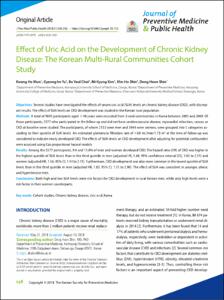KUMEL Repository
1. Journal Papers (연구논문)
1. School of Medicine (의과대학)
Dept. of Preventive Medicine (예방의학)
Effect of Uric Acid on the Development of Chronic Kidney Disease: The Korean Multi-Rural Communities Cohort Study
- Keimyung Author(s)
- Shin, Dong Hoon
- Department
- Dept. of Preventive Medicine (예방의학)
- Journal Title
- Journal of Preventive Medicine & Public Health
- Issued Date
- 2018
- Volume
- 51
- Issue
- 5
- Keyword
- Cohort studies; Chronic kidney disease; Uric acid; Korea
- Abstract
- Objectives:
Several studies have investigated the effects of serum uric acid (SUA) levels on chronic kidney disease (CKD), with discrepant results. The effect of SUA levels on CKD development was studied in the Korean rural population.
Methods:
A total of 9695 participants aged ≥40 years were recruited from 3 rural communities in Korea between 2005 and 2009. Of those participants, 5577 who participated in the follow-up and did not have cerebrovascular disease, myocardial infarction, cancer, or CKD at baseline were studied. The participants, of whom 2133 were men and 3444 were women, were grouped into 5 categories according to their quintile of SUA levels. An estimated glomerular filtration rate of <60 mL/min/1.73 m2 at the time of follow-up was considered to indicate newly developed CKD. The effects of SUA levels on CKD development after adjusting for potential confounders were assessed using Cox proportional hazard models.
Results:
Among the 5577 participants, 9.4 and 11.0% of men and women developed CKD. The hazard ratio (HR) of CKD was higher in the highest quintile of SUA levels than in the third quintile in men (adjusted HR, 1.60; 95% confidence interval [CI], 1.02 to 2.51) and women (adjusted HR, 1.56; 95% CI, 1.14 to 2.15). Furthermore, CKD development was also more common in the lowest quintile of SUA levels than in the third quintile in men (adjusted HR, 1.83; 95% CI, 1.15 to 2.90). The effect of SUA was consistent in younger, obese, and hypertensive men.
Conclusions:
Both high and low SUA levels were risk factors for CKD development in rural Korean men, while only high levels were a risk factor in their women counterparts.
- Keimyung Author(s)(Kor)
- 신동훈
- Publisher
- School of Medicine (의과대학)
- Citation
- Kwang Ho Mun et al. (2018). Effect of Uric Acid on the Development of Chronic Kidney Disease: The Korean Multi-Rural Communities Cohort Study. Journal of Preventive Medicine & Public Health, 51(5), 248–256. doi: 10.3961/jpmph.18.112
- Type
- Article
- ISSN
- 2233-4521
- Source
- https://www.jpmph.org/journal/view.php?doi=10.3961/jpmph.18.112
- Appears in Collections:
- 1. School of Medicine (의과대학) > Dept. of Preventive Medicine (예방의학)
- 파일 목록
-
-
Download
 oak-2018-1655.pdf
기타 데이터 / 426.56 kB / Adobe PDF
oak-2018-1655.pdf
기타 데이터 / 426.56 kB / Adobe PDF
-
Items in Repository are protected by copyright, with all rights reserved, unless otherwise indicated.